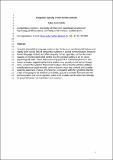Files in this item
Linguistic capacity of non-human animals
Item metadata
| dc.contributor.author | Zuberbuehler, Klaus | |
| dc.date.accessioned | 2016-01-28T00:11:53Z | |
| dc.date.available | 2016-01-28T00:11:53Z | |
| dc.date.issued | 2015-05 | |
| dc.identifier | 172319315 | |
| dc.identifier | 301e48ac-13b4-42a4-a820-bea97a77f4bc | |
| dc.identifier | 84927796165 | |
| dc.identifier | 000353886000009 | |
| dc.identifier.citation | Zuberbuehler , K 2015 , ' Linguistic capacity of non-human animals ' , WIREs Cognitive Science , vol. 6 , no. 3 , pp. 313-321 . https://doi.org/10.1002/wcs.1338 | en |
| dc.identifier.issn | 1939-5078 | |
| dc.identifier.other | ORCID: /0000-0001-8378-088X/work/64360738 | |
| dc.identifier.uri | https://hdl.handle.net/10023/8091 | |
| dc.description | This paper was funded by European Union's Seventh Framework Programme for research, technological development and demonstration. Grant Number: 283871 | en |
| dc.description.abstract | Linguists interested in language evolution tend to focus on combinatorial features and rightly point out the lack of comparable evidence in animal communication. However, human language is based on various unique capacities, such as a motor capacity of sophisticated vocal control and a cognitive capacity of acting on others' psychological states. These features are only present in very rudimentary forms in non-human primates, suggesting they have evolved more recently in the human lineage. Here, the evidence from recent fieldwork for precursors of these abilities is reviewed, notably sequence-based semantic communication, vocal tract control, and audience awareness. Overall, there is evidence for both continuity and discontinuity when comparing modern primate and human communication, suggesting that the origin of language is the result of multiple gradual transitions from earlier forms of primate-like communication and social cognition, rather than a sudden and fundamental redesign in ancestral human communication and cognition. | |
| dc.format.extent | 234989 | |
| dc.language.iso | eng | |
| dc.relation.ispartof | WIREs Cognitive Science | en |
| dc.subject | BF Psychology | en |
| dc.subject | T-NDAS | en |
| dc.subject.lcc | BF | en |
| dc.title | Linguistic capacity of non-human animals | en |
| dc.type | Journal article | en |
| dc.contributor.institution | University of St Andrews. School of Psychology and Neuroscience | en |
| dc.contributor.institution | University of St Andrews. Institute of Behavioural and Neural Sciences | en |
| dc.contributor.institution | University of St Andrews. Centre for Social Learning & Cognitive Evolution | en |
| dc.identifier.doi | https://doi.org/10.1002/wcs.1338 | |
| dc.description.status | Peer reviewed | en |
| dc.date.embargoedUntil | 2016-01-28 |
This item appears in the following Collection(s)
Items in the St Andrews Research Repository are protected by copyright, with all rights reserved, unless otherwise indicated.

